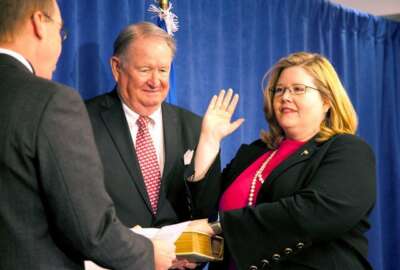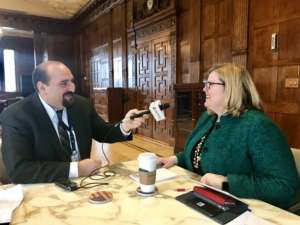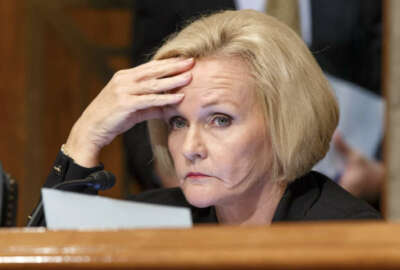
After 120 days, GSA administrator shuffles SES
Seth Harris, a former deputy secretary at the Labor Department, said it’s most important for political appointees to address the aftermath of moving executives...
The calendar marking Emily Murphy’s time as the administrator of the General Services Administration read 120 days, and she wasted little time in putting her mark on the agency.
Murphy moved around, named or made permanent 18 senior executives across the agency. Murphy was sworn in as GSA administrator on Dec. 12.
Among the most significant changes are Jessica Salmoiraghi becoming the new associate administrator for the Office of Governmentwide Policy (OGP), Joanne Collins-Smee losing her “acting” title to become the permanent deputy commissioner of the Federal Acquisition Service and director of the Technology Transformation Services (TTS), and two well-known federal executives heading out to the regions: Tony Costa moves to be regional commissioner for the Public Building Service in the Northeast and Caribbean Region, and Giancarlo Brizzi will move to Texas where he will be regional commissioner of PBS in the Greater Southwest Region.
Costa previously served as a senior adviser to the administrator as well as acting deputy administrator and chief human capital officer at GSA. Brizzi previously served as principal deputy associate administrator for OGP and currently is the acting chief of staff for GSA.
Salmoiraghi comes to GSA after serving as the director of federal agencies and international programs at the American Council of Engineering Companies. In that role, she focused on federal and international procurement issues that affected engineering firms. She also was the director of federal relations and counsel at the American Institute of Architects where she led the Institute’s advocacy and outreach efforts before the executive and legislative branches.
Here is a full list of all the SES changes at GSA.
Murphy, like most new political appointees, by law has to wait to reassign or move Senior Executive Service (SES) members into new positions. Part of the reason for the four-month time period is to let new leaders get to the people and mission of their new agency. Even someone like Murphy who was well-steeped in GSA, having worked there in the mid-2000s and having overseen some aspects of the agency during her time on Capitol Hill, still needs to get to know career SESers and understand their strengths and weaknesses.
So it got me thinking about what really goes into an executive’s decision to move people around.
Seth Harris, a former Labor Department deputy secretary, had a similar experience as Murphy. When he joined Labor as part of the Obama administration, it was his second tour with the department.
Harris, who now is runs his own law firm, Seth D. Harris law and policy, and is a visiting professor at Cornell Institute for Public Affairs, said as soon as new political appointees arrive, career and political executives are whispering in your ear.

“The task is to sort through what is politics, what is interpersonal strife and what are real leadership challenges,” Harris said in an interview. “That is why 120-day rule is a very important rule. As someone whose hands were tied by that rule, you really need to learn before you make any decision about what should and shouldn’t happen with SESers. It’s not just a cooling off period, but a moving up the learning curve period.”
I didn’t ask Harris to comment specifically on GSA’s moves as he isn’t familiar with the agency or the people. But from his experience, any new political appointees at any agency must follow a similar path toward the 120-day mark. He said they must research, listen and learn in those first four months.
“Sometimes you are moving people because they may not be good at their job or them being in that job suppresses more junior people from moving up, but too often it’s perceived by people in the SES as punishment,” he said. “There is a grade compression problem in the government when people get to GS-13, and you have to move into a supervisory role in most places to put you on a path toward SES status, but not everyone should be a supervisor or a manager or an executive. I’ve encountered people who were not suited for the SES. And because those slots are so valuable, and the career SES are so critical to the management of government, if you have someone who is not well suited for management, it’s a lost resource.”
Some decisions to move executives are straightforward. Harris said he got a call during his 120 day period from a manager who said his office couldn’t account for $11 million.
“Whoever was in charge wasn’t doing a good job,” he said. “You don’t often see things like that. We got rid of the top career leader in that organization and the person doing the financial management was moved out.”
Most of the time, Harris said, it takes personal engagement with each of the leaders.
“There is a very interesting interpersonal dynamic that goes on between the political leadership and those they are surrounded by, the career leaders. It becomes a work family in many ways. It’s not necessarily a well-functioning family sometimes,” he said. “So dislodging someone from that work family can be very challenging. It forces leaders to make hard choices and the only way you can do that is based on having very clearly defined individual performance plans tied to agency performance plans. You also have to look at whether one’s personality doesn’t work in the role they are in or at all. And third, are there ethical or legal challenges that you need to consider. The third thing is the easiest because then you can take a straightforward personnel action. But with all three of these, partisan politics should never play a role in these decisions.”
Harris said the decision to move executives around may be the easier part of the post-120 period. All the political leaders, like Murphy, must deal with the change management piece of dislodging the work family.
“It is extremely challenging to deal with the change management piece. It matters who you pick to move up, and if it looks like you picked a flunky or kiss up, it will go badly. If you picked someone who is well qualified and respected in the organization, and whose mere selection signals success matters then it’s that person and their boss’ job to communicate through the organization where the agency is going and why,” he said. “What front line supervisors and other senior career leaders are saying matters a lot more than what the secretary or deputy secretary are saying.”
Good advice for Murphy, and every new political appointee because there is only one way to get the administration’s priorities successfully completed — getting the career staff to lead them.
Read more of the Reporter’s Notebook.
Copyright © 2025 Federal News Network. All rights reserved. This website is not intended for users located within the European Economic Area.
Jason Miller is executive editor of Federal News Network and directs news coverage on the people, policy and programs of the federal government.
Follow @jmillerWFED
Related Stories





